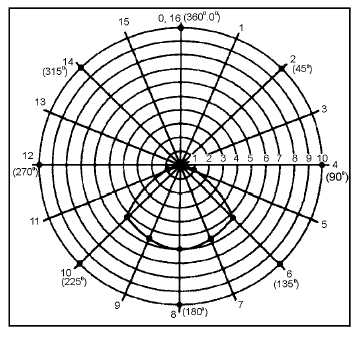4-17
Figure 4-12.—Polar-coordinate graph for anisotropic radiator.
The positions marked off on the two polar-coordinate graphs in figures 4-10 and 4-12 were selected
and numbered arbitrarily. However, a standard method allows the positions around a source to be marked
off so that one radiation pattern can easily be compared with another. This method is based on the fact
that a circle has a radius of 360 degrees. The radius extending vertically from the center (position 0 in
figure 4-10) is designated 0 degrees. At position 4 the radius is at a right angle to the 0-degree radius.
Accordingly, the radius at position 4 is marked 90 degrees, position 8 is 180 degrees, position 12 is 270
degrees, and position 16 is 360 degrees. The various radii drawn on the graph are all marked according to
the angle each radius makes with the reference radius at 0 degrees.
The radiation pattern in figure 4-12 is obtained by using the same procedure that was used for (figure
4-10, view B). The radiation measured at positions 1, 2, 3, and 4 is 0. Position 5 measures approximately
1 unit. This is marked on the graph and the rotating radius moves to position 6. At this position a reading
of 5.5 units is taken. As before, this point is marked on the graph. The procedure is repeated around the
circle and a reading is obtained from positions 6 through 11. At position 12 no radiation is indicated, and
this continues on to position 16.
The polar-coordinate graph now shows a definite area enclosed by the radiation pattern. This pattern
indicates the general direction of radiation from the source. The enclosed area is called a LOBE. Outside
of this area, minimum radiation is emitted in any direction. For example, at position 2 the radiation is 0.
Such a point is called a NULL. In real situations, some radiation is usually transmitted in all directions.
Therefore, a null is used to indicate directions of minimum radiation. The pattern of figure 4-12 shows
one lobe and one continuous null.
ANTENNA LOADING
You will sometimes want to use one antenna system for transmitting and receiving on several
different frequencies. Since the antenna must always be in resonance with the applied frequency, you may
need to either physically or electrically lengthen or shorten the antenna.

